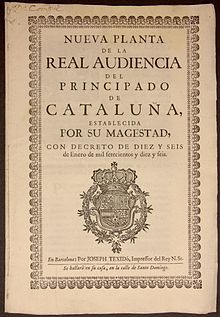Decretos de Nueva Planta
The Decretos de Nueva Planta (freely translated: ordinances for thorough renewal ) consisted of a whole series of ordinances. Philip V issued them from June 1707 , partly during the War of the Spanish Succession , in order to standardize the government, administration and legal system in all of the areas of Spain he ruled. In the lands of the Crown of Aragón in particular , power was shared between the Corts and the king through the privileges of the nobility and the Corts . The political goal of the Decretos de Nueva Planta was to abolish these special rights and transform Spain into an absolutist unitary state. Since King Charles I came to power in 1516, the various dominions of the Crown of Castile and the Crown of Aragon were united under one monarch . In practice, however, it was just a personal union . In the various kingdoms, Kingdom of Castile , Kingdom of Aragon , Principality of Catalonia , Kingdom of Valencia , Kingdom of Navarre , Sicily , etc., there were separate assemblies of estates (Cortes), which strictly ensured that courts decided on their territory according to the respective local law and the special privileges and Traditions of the ruled areas were observed.
The Decretos de Nueva Planta primarily had an impact on Valencia, Aragón, Catalonia and Mallorca :
- Most of the special rights of the individual domains were abolished.
- The Cortes in the realms of the Crown of Aragon and many other council assemblies in these lands were abolished.
- Except in Valencia, decisions were only made in the area of private law according to local law.
- The national languages were ignored, the Castilian language is imposed.
- A captain general appointed by the king was the highest military and political commander.
- The posts in the upper courts were filled with people who sympathized with the Bourbons .
- The right that high positions in administration, the judiciary and the military could not be filled with “foreigners” was abolished. Positions in Aragón could now also be filled with Castilians.
- In the big cities, as in Castile, city councils were appointed for life. The assembly ( Cabildos ) was presided over by a corregidor appointed by the king.
- The customs borders between Castile and Aragon were abolished.
- A new system of collection of duties and taxes has been developed across Spain.
literature
- Ramón Bonell Colmenero: Los Decretos de Nueva Planta . In: Saberes. Revista de estudios jurídicos, económicos y sociales . tape 8 , 2010, ISSN 1695-6311 (Spanish, uax.es [PDF; accessed January 31, 2015]).
Web links
Individual evidence
- ↑ Ramón Bonell Colmenero: Los Decretos de Nueva Planta . In: Saberes. Revista de estudios jurídicos, económicos y sociales . tape 8 , 2010, ISSN 1695-6311 (Spanish, uax.es [PDF; accessed January 31, 2015]).
- ^ Antonio Viller: Los Decretos de Nueva Planta. The final of the Corona de Aragon. iHistoriArte, October 2013, accessed January 31, 2015 (Spanish).
